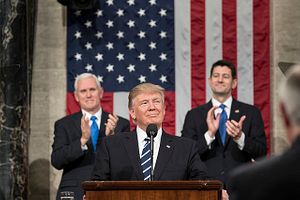With traction gathering for a renegotiation of the free trade agreement between the United States and South Korea, a key driving force, ironically, has been common sense. The argument goes as follows: when a country imports more than it exports (i.e. has a trade deficit), it loses money because it is buying more goods than it is selling. This is a very simple perspective that applies well to the financial health of a company, something President Donald Trump and the various ex-CEOs on his cabinet, including Commerce Secretary Wilbur Ross, understand well. The problem is this simplistic view does not really apply to the economy of an entire country, as it ignores several important complexities.
Take, for example, the fact that an investment in a foreign company is actually an export. Let’s say a U.S. company called “Happy Play” wants to build a toy factory in California. To do this, Happy Play must purchase building materials, land, building services, machinery for building toys, and the labor to make toys. To purchase these goods and services, Happy Play has two choices: it can either pay cash or receive investments.
Most companies don’t have large amounts of cash just sitting around so they usually need investments to cover the cost. Happy Play can receive these investments by selling its own stock or other assets it owns (i.e. perhaps Happy Play owns some stock in Coca Cola or a building in New Jersey). If the investor who buys Happy Play stock is Korean, the United States is effectively receiving an import of foreign capital. Since the Happy Play stock the Korean investor buys is still a part of a U.S. company, the stock itself functions as neither an export nor an import (it is an asset). The dividends earned from the stock, however, become money exported from the United States and imported into Korea. Since the Korean investment creates new jobs and consumption in California, it is hard to say this is a bad thing for the U.S. economy.
The opposite of an investment (money coming in) is a saving (money going out). Let’s say Happy Play does really well with its new factory and makes a lot of money. This money will do one of two things: go into a bank or be invested by Happy Play. If Happy Play invests the money in a foreign company, it is now exporting that capital overseas. If the money goes into a bank, the bank will invest the money, sometimes domestically, sometimes abroad. If the investment is made abroad, that again becomes an export with future earnings being imported back. In this way, even savings participate very directly in trade deficits: if a country is not saving as much, it is exporting less capital. With U.S. household savings at very low levels, this becomes one of the key reasons for a low export value.
Another trend that adversely affects import/export balance is the fact that the United States is the preferred “safe haven” for global investments. Just about every bank or investment firm in the world has a preference for investing in U.S. companies, currency, and government bonds, as these are considered to be some of the safest items on the market. This fact alone makes it virtually impossible for the United States to ever have anything but an import (investment) surplus because foreign capital is always flowing in more than domestic capital is flowing out.
One of the consequences of heavy investment in the U.S. dollar is overvaluation. Not only is the dollar the most frequently used currency in international trades but it is also one of the preferred investment currencies for such things as mutual funds. This raises the strength of the dollar compared to other currencies. On the face of it, common sense might suggest this a good thing — when is being “weak” ever good, right? — but, in fact, the strength of the dollar is something that directly hurts U.S. export products. Let’s go back to Happy Play to see why.
Let’s say Happy Play can make toys at a labor rate of $1 per toy. It can sell each toy in South Korea for 1,500 Korean won. If the exchange rate is 1,000 Korean won/dollar, Happy Play makes 500 won per toy. However, if the currency exchange rate changes to improve the strength of the dollar, making it 1,200 won/dollar, then Happy Play makes 200 won less profit per toy. Conversely, Korean exports are helped by a strong dollar. If a Korean toy company makes toys at a labor rate of 1,000 won per toy and sells them for $2 in the United States, the exchange rate change from 1,000 won/dollar to 1200 won/dollar improves the profit margin from 1,000 won to 1,400 won. With South Korea’s currency having steadily devalued in the last year, it is not surprising to see some accuse the government of currency manipulation.
In summary, the common sense view of “treating a country like a company” is surprisingly misguided, ignoring a few critical facts about trade deficits and how import/export numbers are derived. The first is that import/export figures aren’t just about buying and selling physical goods: investments and savings also participate very actively in these numbers. The second is that confidence in the U.S. economy actually works to create trade deficits (with more investment coming in than going out). The third is the fact that a strong dollar is exacerbated by this confidence, working to make U.S. exports less competitive and less profitable. Adding tariffs or taxes on Korean goods imported into the United States may marginally improve the U.S. government’s revenue but it will do little to address the larger underlying issues that perpetuate trade deficits.
Justin Fendos is a professor at Dongseo University in South Korea and the associate director of the Tan School at Fudan University in Shanghai.

































